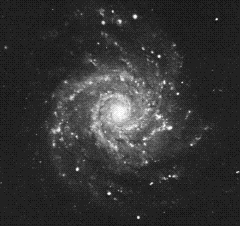
Astronomy 358
#45075
G A L A X I E S
Fall 1998 - *updated 15 September 1998*
Meetings: Tuesdays and Thursdays, 11:00 AM-12:15 PM
RLM 15.216B, the Astronomy department classroom
Instructor: Dr. Harriet L. Dinerstein, RLM 16.324
Office Phone: 471-3449
E-mail: harriet@astro.as.utexas.edu
Office Hrs.: W 3:00 - 4:00 p.m., TH 2:00 - 3:00 p.m.
T.A.: Zhaohui Shang, RLM 16.220
Office Phone: 471-3447
E-mail: shang@astro.as.utexas.edu
Office Hrs.: T 1:00 - 2:00 p.m., F 1:30 - 2:30 p.m.
Prerequisites, Subject Matter, and Goals: Astronomy 358 is
an upper-division elective for astronomy majors and others with
appropriate background. The prerequisites are two semesters of
lower-division college physics and the associated math (simple
calculus); it is helpful, although not required, to have taken at least
one college course on astronomy at the level of AST 307 or above. AST
358 was created in order to make a place in our curriculum for such
topics as the structure of the Milky Way Galaxy, interstellar matter,
properties of normal and active galaxies, and the
large-scale structure and history of the Universe. The level is similar
to that of AST 352K, General Stellar Astronomy. A cautionary note: it
is a very ambitious undertaking to cover all of Galactic and
extragalactic astronomy in one semester. However, we hope to provide a
broad and interesting introduction to many of the
major frontiers in astronomical research today.
Textbook: The main written source for course content will
be the Instructor's Notes, hard copies of which will be on reserve
on the PMA Library on the ground floor of RLM Hall. As a secondary
text, we will also use a new book by Debra Meloy Elmegreen
(an authority on the structure of galaxies), "Galaxies and
Galactic Structure" (publication date 1998).
Other useful books and materials will be kept on reserve in
the PMA library.
Course Requirements and Grading Breakdown:
Homeworks: 25% : the HW with the lowest score (only one)
will be dropped.
Term paper: 15%: length < 8 double-spaced pages, due
around Nov. 19.
Exams: Two hour exams, 25% each. Tentative dates:
Oct. 13, Dec. 3.
Class Participation: 10 %.
- Term Paper: Part of the purpose of the term
paper is to enable each student to look more deeply
into a topic of interest, that may or may not be covered in
detail in class. It will also serve as an introduction
to using the astronomical literature. A
list of suggested topics will be provided, but you will be able to
select alternate topics as long as they are relevant to the course
subject matter. At least two of your sources for the term
paper must be papers in professional journals. There will be a
presentation on electronic and library resources during one of our
class sessions early in the semester.
- Homework Policies: You may discuss the background and
general approach to the homework problems with your classmates if you
wish, but the paper that you finally turn in must represent your own
work and understanding of the problem. We
encourage you to seek help from the instructor or TA if you have
trouble getting started.
Methods for getting help include attending regularly scheduled office
hours, setting up an appointment with the instructor or TA, and asking
questions by e-mail.
Homeworks will be assigned roughly every 1-2 weeks depending on the pace
of the lectures. It is expected that homeworks will be
turned in on time. Late homeworks that are received
within 24 hours after the deadline will be graded but be given
substantially diminished credit. After 24 hours, they will not be
graded or given credit. You will be allowed to drop one (and only one)
homework grade, to cover emergencies and provide
flexibility.
- Exam Format and Policies: The exams will be closed-book,
closed-notes, and in class. You will be expected to bring calculators,
since some of the exam problems may involve simple calculations. You
will be given a set of relevant equations and values of constants at
each exam. This eliminates the need for you to memorize, so that you
may concentrate on understanding the material and how to apply the
equations. In addition, you will usually have some choice of
questions to answer, on various topics.
- Major Topics:
- I. The Milky Way as a Galaxy: stellar populations and structural
components, interstellar matter, motions of the stars and gas, theories
of formation, satellite galaxies
- II. Galaxies: properties and types of normal galaxies, star
formation patterns, "activity" (both starbursts and active
nuclei), galaxy-galaxy interactions and consequences
- III. Cosmology: galaxy clustering, Hubble expansion, the
extragalactic distance scale, galaxy evolution, large-scale structure
and flows
